How to improve employee engagement and retention

 13 minute read
13 minute read
People often say companies prioritize profit over employees, while employees focus only on themselves. However, the relationship between employees and companies is reciprocal. When companies prioritize employee satisfaction and experience, they become motivated and engaged.
Engaged employees resonate with the company culture and consistently take positive actions. They become true company ambassadors and are less likely to seek new jobs.
Focusing on keeping and engaging employees can drive positive changes within your organization. To achieve that, you should understand how employee engagement impacts retention and use that knowledge to develop a dedicated employee engagement strategy.
What is employee engagement?
Employee engagement measures the degree to which your employees are invested emotionally and mentally in the work. It reflects a deep connection and commitment to the company’s mission, values, and goals.
Unlike simple metrics, like attendance or tenure, employee engagement shows active participation in company life.
Engaged employees take initiative, collaborate with colleagues, and seek personal and professional growth opportunities. They typically show higher performance, which results in a company’s success and profitability.
Learn more about how to improve employee engagement and keep your team motivated and productive.
What is employee retention?
Employee retention, or talent retention, includes all organizations’ efforts to reduce employee turnover.
Contrary to the belief that companies can improve job satisfaction and retention solely by providing competitive compensation and perks, modern human resource management embraces a more holistic approach.
This approach covers the entire employee experience, from onboarding and recognition to fostering a positive work environment, effective internal communication, and work-life balance.
Understanding how these factors impact retention is essential for an effective employee retention strategy.
How does employee engagement contribute to employee retention?
Creating a company culture that engages employees can significantly impact your average retention. This means that engagement is one of the strongest indicators of employee turnover.
Formerly, companies relied on exit interviews solely to discover why employees leave. Nowadays, you don’t have to wait until it’s too late to determine why employees quit.
Running regular employee engagement surveys allows you to gather real-time data and understand the pain points affecting retention. This creates an advantage in that you can choose to be proactive and prevent turnover before an employee decides to leave.
You can also notice higher employee engagement as the following outcomes:
- Increased job satisfaction: Engaged employees are more satisfied with their work. They are aligned with the organization’s goals and values. Being confident with your work reduces the likelihood of seeking opportunities elsewhere.
- Sense of belonging: Engaged employees feel a sense of belonging in the organization. This leads to more commitment, loyalty, and higher retention rates.
- Opportunities for growth and development: Organizations prioritizing employee engagement often provide growth and career development opportunities. Employees who want to improve their skills are likely to stay with a company that invests in their development.
- Positive work environment: Initiatives for employee engagement, like recognition programs and supportive leadership, improve work and lead to a positive environment. Engaged employees feel valued and appreciated, which increases job satisfaction and retention.
- Better relationships with managers and colleagues: Engaged employees usually have stronger relationships with their managers and colleagues. Supportive relationships in the workplace create a sense of community and belonging, reducing employee turnover.
- Higher productivity and performance: Gallup found engaged employees significantly boost customer satisfaction. Businesses with engaged team members might see up to 10% higher customer ratings. They are dedicated to work and the organization. This commitment leads to better performance and raises retention rates.
- Resilience in challenging situations: Engaged employees are more likely to endure business challenges such as hypergrowth, mergers, or economic downturns. Their strong sense of purpose in the organization lets them stay loyal to their employer.
7 actionable tips to improve employee engagement and retention
You have many opportunities to ensure talent retention and help your employees feel connected to the organization and motivated to do their best.
Pick one or all seven tactics from the list and build an effective employee engagement strategy.
1. Streamline onboarding
Effective onboarding sets the tone for an employee’s entire journey with the organization. The more detailed and structured, the faster the new employee becomes productive.
Your goal should be to set clear expectations for your new team members, introduce them to the company culture and values, and provide the necessary resources to succeed.
A well-executed onboarding process ensures employees feel welcomed and prepared for their new roles. This positive experience fosters early engagement and sets the stage for long-term organizational commitment.
How can you achieve your goal?
- Implement a structured onboarding program that includes
- personalized welcome messages,
- clear job expectations,
- training sessions,
- regular one-on-one check-ins, and
- employee surveys.
- Assign a new employee an onboarding buddy or mentor to facilitate his integration into the team.
- Use human resource technology to automate repetitive tasks during onboarding and free up the new team member’s time for more meaningful work.
2. Create a positive workplace culture
In a positive work culture, employees feel valued, supported, and motivated to contribute to their best work. Engaged employees are more likely to thrive in such a culture, leading to higher job satisfaction and retention levels.
How can you achieve this goal?
- Organize team-building activities and social events to strengthen relationships among employees.
- Encourage open communication, celebrate achievements, and recognize employees who embody the organization’s values.
- Ensure that senior leadership leads by example and participates actively in such events.
- Introduce an employee experience platform like HeartCount, which can enhance internal communication and provide real-time insights into employee well-being.
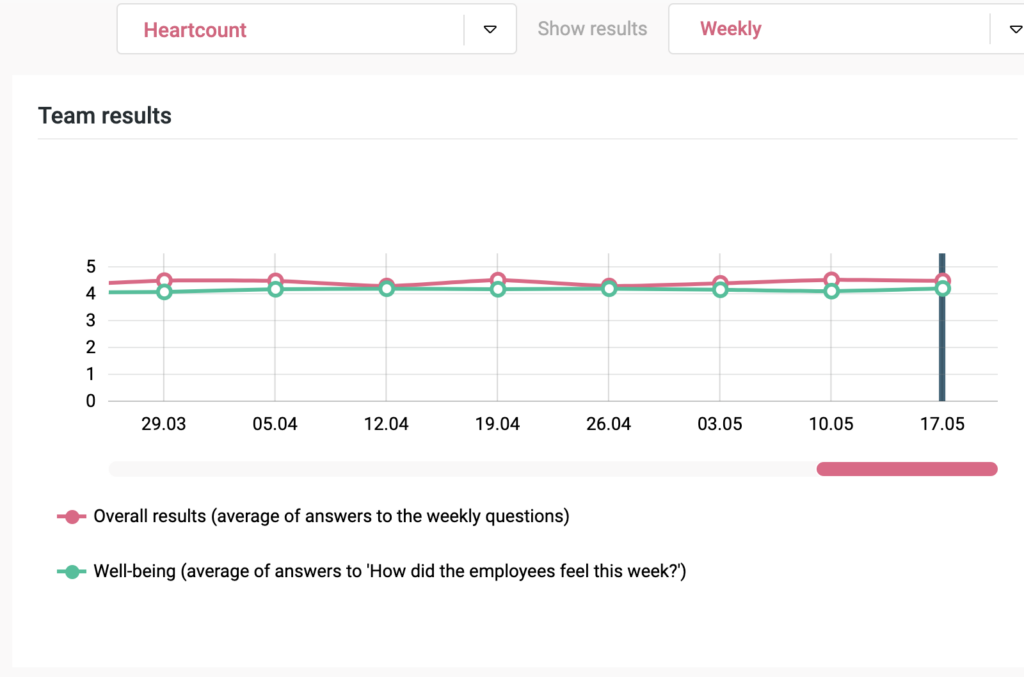
3. Design a safe environment for regular feedback
Leaders can understand employees’ needs and concerns by regularly soliciting employee feedback through surveys, pulse checks, focus groups, or one-on-one meetings.
Listening to employees demonstrates that their voices are valued and their input is considered in decision-making. Addressing their feedback helps to improve morale, engagement, and retention by showing employees that their opinions matter.
How can you achieve this goal?
- Acknowledge every feedback you receive, thank whoever gave it, and be transparent about how you’ll address it and why. This creates safety and reassures employees their voice is heard and that it’s not in vain and just a formality.
- Share the findings from pulse check surveys transparently during all-hands meetings and town hall sessions to involve the employees and encourage them to voice their suggestions. Pulse surveys don’t mean much if you don’t take your time to analyze the feedback and act on it by developing action plans to address critical findings.
- Using the HeartCount platform, you can track essential employee satisfaction and engagement metrics in real time. This can reduce turnover rates and boost retention, as you can react quickly if you notice alarming responses from your employees.
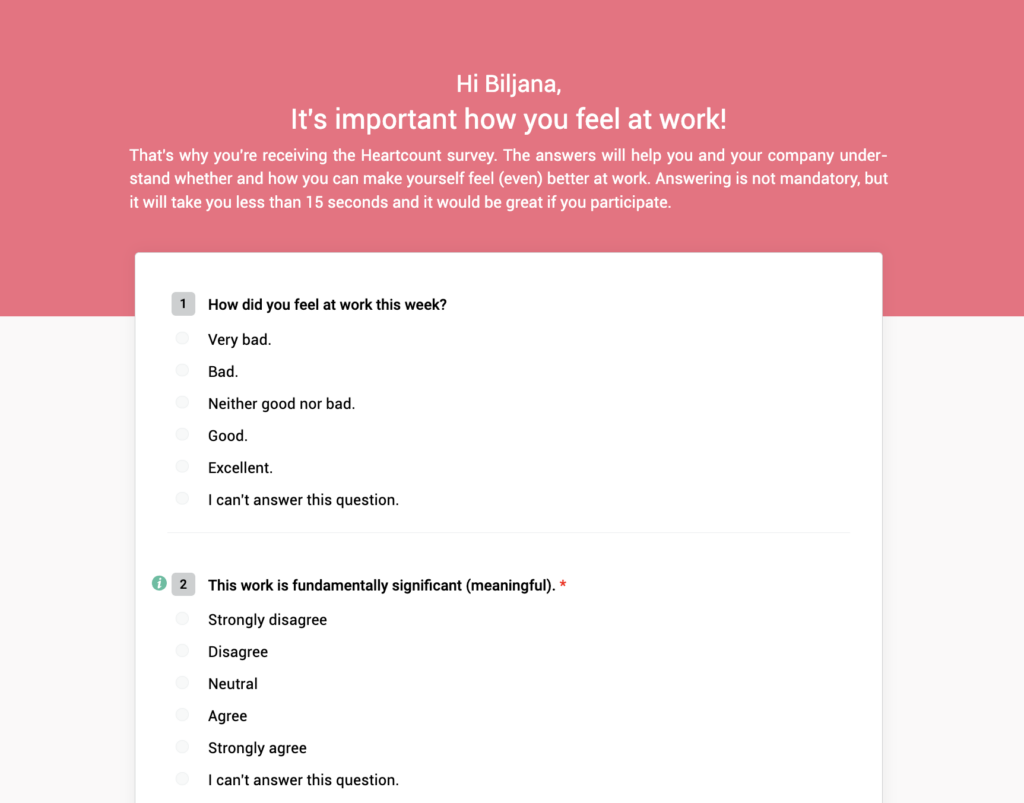
4. Help employees connect with their purpose
When employees feel connected with their purpose within an organization, their values, strengths, and passions align with their responsibilities at work.
If you make your employees’ roles meaningful by emphasizing the impact of their contributions, they’re more likely to stay with you longer.

How can you achieve this goal?
- Focus on employees’ strengths and improvement opportunities
- Talk with them about their career aspirations, goals, and things they’d be proud to achieve for themselves, their team, and the organization.
- Encourage your employees to reflect on how their work contributes to the organization’s mission and how their personal purpose fits the company’s, understanding the alignment between them.
5. Establish well-being as a priority
In one study by the American Institute of Stress, more than 25% of respondents believe their jobs are the number one source of stress in their lives.
Implementing initiatives to support work-life balance, stress management, and overall wellness can help your employees feel valued and avoid burnout.
Employee well-being encompasses your team members’ physical, mental, and emotional health. According to 90% of employers, focusing on employee wellness can positively impact their performance and productivity and consequently help boost their engagement rates.
How can you achieve this goal?
- Implement policies and programs promoting work-life balance, such as
- firm boundaries,
- realistic workloads and deadlines,
- flexible work arrangements,
- remote work options, and
- wellness initiatives.
- Provide resources and support for mental health and stress management, such as
- employee assistance programs,
- mindfulness training, or
- counseling services.
For example, Inviggo is a software development company that offers its employees regular sessions with psychotherapists if they need or want them.
- Encourage regular breaks, promote a culture of self-care, and lead by example by showing that leadership also prioritizes the well-being of their team.
For example, with HeartCount, you can regularly measure eight engagement categories, including well-being.

Here is an example of the message that leads employees to the weekly pulse check survey.
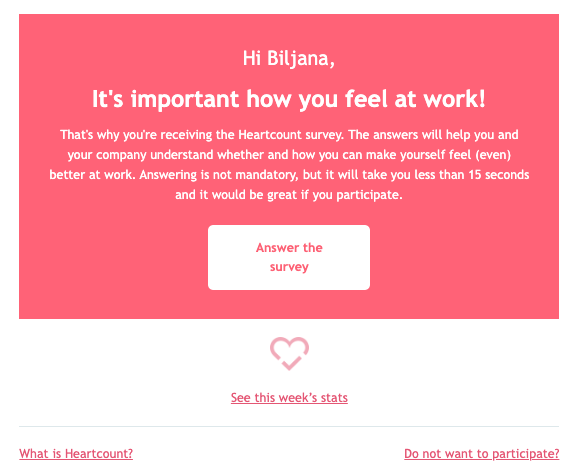
Every respondent can share their qualitative feedback, accessible only to people authorized to see it. You can also create a custom survey and send it to any group in your organization to source insights, needs, and opinions.
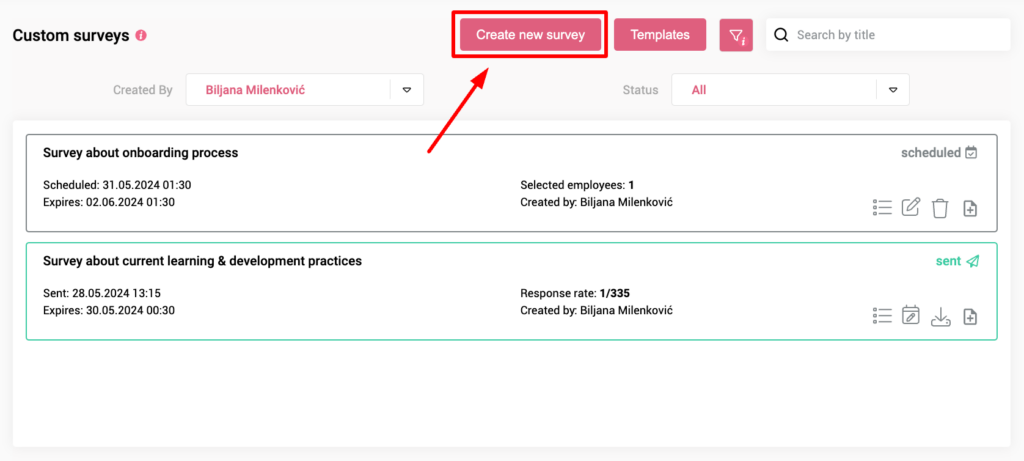
Next, fill out the basic information about your survey. Add a title and description and choose whether it will be anonymous or public. Then, send it to all employees, specific teams, or individuals.
After hitting the next button, define your questions. You can choose open-select, multi-select, or single-select questions. Additionally, you can specify whether the question will be required or optional.
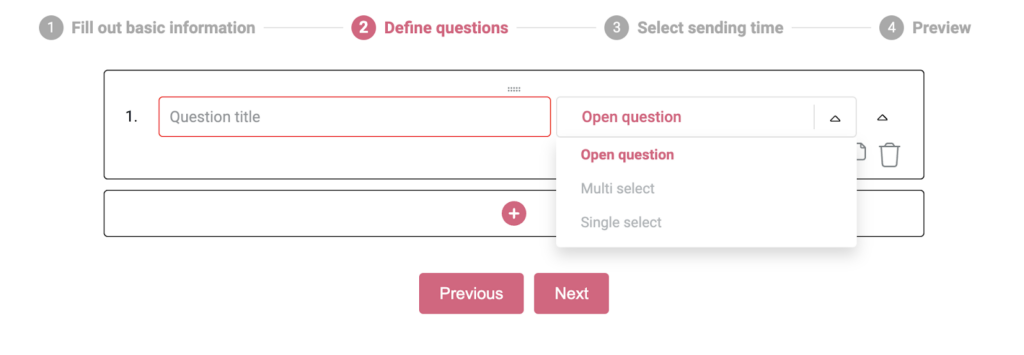
The next steps concern the timing of your survey. You can send it immediately or schedule it for later. In this step, you should set the expiration date for your survey as well.
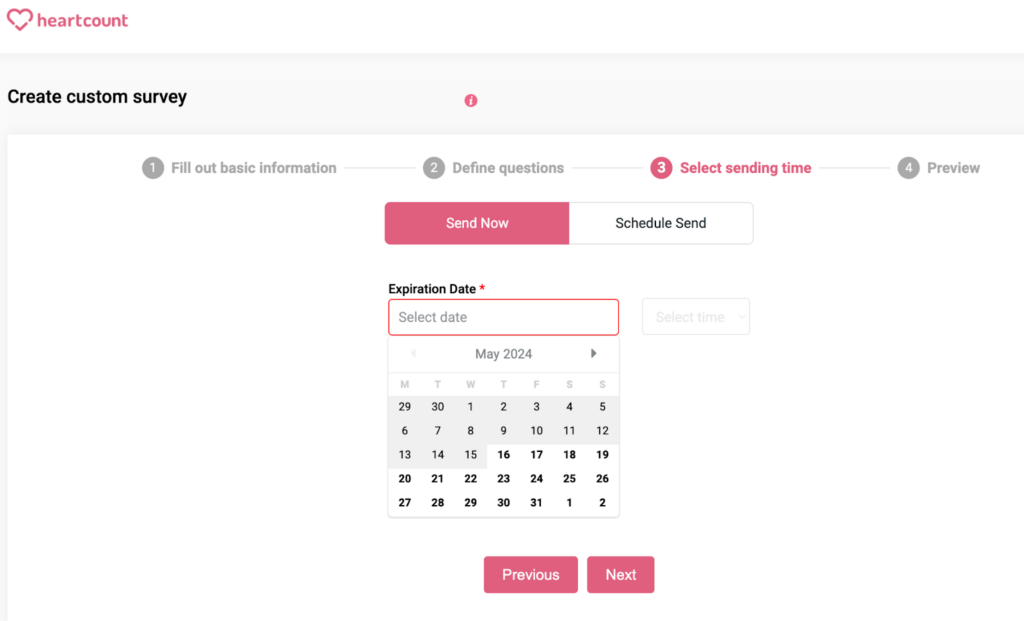
Everything is ready? Preview your survey to check if there’s anything to be adjustid. If all is good you can send it or schedule for a specific date.
6. Show employees that you appreciate them
Employee recognition involves acknowledging and rewarding employees for their contributions, achievements, and organizational commitment. This can include verbal praise, awards, bonuses, promotions, or other tangible incentives.
Recognizing and appreciating your employees reinforces positive behaviors, boosts morale, and fosters a sense of pride and loyalty. Employees who feel valued and appreciated are more likely to remain engaged and committed to their roles.
How can you achieve this goal?
- Establish a formal recognition program celebrating your employees’ accomplishments, milestones, and exceptional performance.
- Recognize individuals and teams during meetings, through company-wide announcements, or with personalized notes from leadership.
- Make sure your appreciation is also reflected in employee compensation. Regular raises and tailored perks are vital in attracting and retaining top talent.
Bringing HeartCount into your efforts to improve organizational culture will facilitate public peer recognition inside the company. You will equip employees to give and receive kudos or add to someone else’s praise. Peer recognition is visible to the whole company and is saved in the employee’s record, never to be forgotten.

7. Give employees opportunities to grow and develop
Employees are more likely to feel engaged if they can visualize their professional growth within your organization and if you can help them create a career path with opportunities to develop their skills.
Whether you offer training programs, educational resources, mentorship, or career advancement opportunities, investing in employee development demonstrates a commitment to their long-term success and career progression.
This will make the employee more likely to want to stay with your company for a longer time.
How can you achieve this goal?
- Offer regular training sessions, workshops, and access to online learning platforms to help employees develop new skills and stay updated on industry trends.
- Implement a mentorship program where experienced employees mentor junior staff, providing guidance and support for career development.
- Create clear pathways for career advancement and encourage talks about professional growth during performance review cycles.
Related: Should you Measure Engagement or Happiness?
Measuring employee engagement and retention
Monitoring and measuring engagement levels in your company can help predict retention rates and develop strategies to improve them.
Here are a few ways in which you can measure employee engagement:
- Employee pulse check metrics: Through employee pulse checks, you can collect the data necessary to measure different employee engagement metrics, such as
- response rate,
- participation rate,
- employee engagement index, and more.
By measuring these metrics, you can learn about the overall sentiment within your company, predict retention rates, and more.
- Turnover rates and tenure analysis: Monitoring turnover rates and analyzing employee tenure provides insights into employee retention and engagement. High employee turnover rates may indicate dissatisfaction or disengagement, while longer tenures suggest a more committed workforce.
- Recognition and appreciation metrics: Tracking metrics related to employee recognition and appreciation, such as the frequency of recognition events, nominations for awards, or participation in appreciation programs, provides insights into the level of appreciation and employee morale within the organization. Higher levels of recognition and appreciation often correlate with increased employee engagement and satisfaction.
- Engagement with development opportunities: High employee engagement with development opportunities, such as training programs, workshops, or mentorship initiatives, can indicate their interest in learning and growing within the organization. Actively engaged employees seek out and participate in these opportunities to enhance their skills and advance their careers.
- Attendance: Tracking employees’ attendance provides indicators of their commitment and engagement with their work. Consistently high attendance rates may suggest a strong sense of responsibility and engagement, while frequent absences or tardiness may indicate disengagement or dissatisfaction.
- Performance metrics: Evaluating employee performance against established metrics and goals provides insights into their motivation and engagement levels.
High-performing employees who consistently meet or exceed performance expectations will likely be more engaged and motivated in their roles and look to grow within the organization, indicating their intention to stay. - Internal promotion rates: Analyzing internal promotion rates and the percentage of job openings filled internally highlights opportunities for career advancement and growth within the organization. Higher internal promotion rates indicate a culture that values employee development and engagement.
- Employee Net Promoter Score (eNPS): The eNPS measures how likely an employee is to recommend their organization as a place to work. You can calculate it based on a single survey question: asking employees how likely they are to recommend their workplace to others. A higher eNPS score indicates greater employee satisfaction, engagement, and loyalty.
How to improve talent retention and engagement with an employee experience platform
Investing in employee engagement is not only crucial for the well-being of employees but also for the sustainable growth and prosperity of the organization as a whole.
By implementing the tactics we shared in this guide, you can create a work environment where employees feel valued, motivated, and committed, leading to increased productivity, retention, and overall success. You can implement employee engagement platforms such as HeartCount to achieve this quickly and easily.